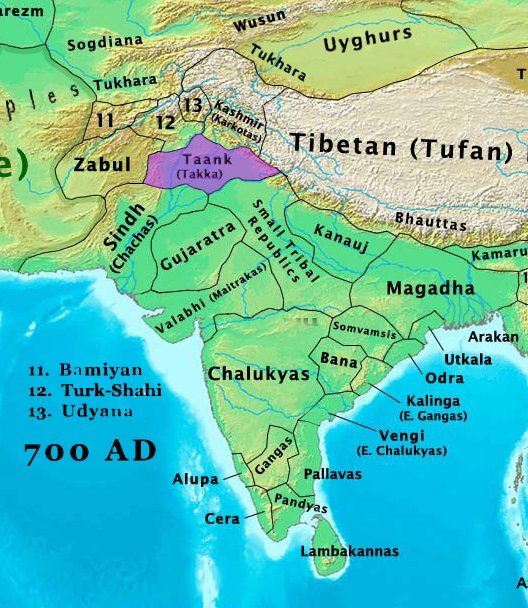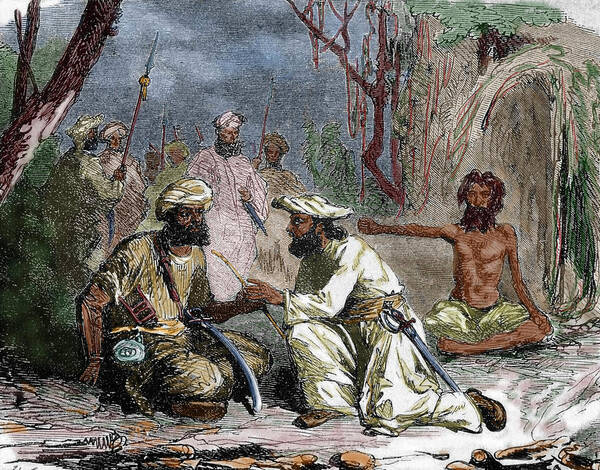How do we know that Muzaffarid dynasty of Gujarat sultanate which ruled such huge landmass was native Indian Muslim (converts from Hinduism) ?
Let us read in detail about the Rajput and Gangetic origins of the Muzaffarids in the light of primary sources.
[🧵THREAD🧵]


Let us read in detail about the Rajput and Gangetic origins of the Muzaffarids in the light of primary sources.
[🧵THREAD🧵]


Mirat-i-sikandari states that Zafar Khan, the founder of sultanate, was a Tāk (تاک) belonging to Kahteri (کهتري) tribe.
Mirat-i-ahmedi says same except instead the word Tāk, uses the word Tānk (تانک).
Both attest their Suryavanshi lineage going back till Rajah Ramachandra.



Mirat-i-ahmedi says same except instead the word Tāk, uses the word Tānk (تانک).
Both attest their Suryavanshi lineage going back till Rajah Ramachandra.



What is this ‘Kahteri’? Some writers have unfortunately mistaken it for ‘Khatri’.
In reality, the word Kahteri (کهتري) refers to Chhatri/Kshatriya and has been used solely for Rajputs by Mughal historians.
Ain-i-Akbari & an older Mughal inscription dated 1538 CE affirms this.




In reality, the word Kahteri (کهتري) refers to Chhatri/Kshatriya and has been used solely for Rajputs by Mughal historians.
Ain-i-Akbari & an older Mughal inscription dated 1538 CE affirms this.




Moreover, a much older source than both Mirat-i-sikandari and Mirat-i-ahmedi attests the Kshatriya lineage of Sultan Fateh Khan (popular as ‘Mahmud Shah Begada’).
‘Jarabakshapatasühi Sri Mahamida Suratrana Charita’ of Kavi Udayaraja which was completed in 1460s is that source.



‘Jarabakshapatasühi Sri Mahamida Suratrana Charita’ of Kavi Udayaraja which was completed in 1460s is that source.



Now since it is firmly established that Muzaffarids were Rajputs (Kshatriyas), so from where did they come from?
Tāk/Tānk are a different name for the word Takshak, which is and was a Kshatriya tribe. It means ‘snake’ in Sanskrit.
‘Tāk, Tānk, Tāki, Takshak, Naga’ mean the same.


Tāk/Tānk are a different name for the word Takshak, which is and was a Kshatriya tribe. It means ‘snake’ in Sanskrit.
‘Tāk, Tānk, Tāki, Takshak, Naga’ mean the same.


Mahabharata (claimed to be 2,300 years old) states that Takshak dwelled in Kandava forest (situated in Gangetic plain near Delhi).
However, even inscriptions dated as early as 400 BCE mention the dwelling and presence of Takshaks (Nagas) in Gangetic cities like Mathura.




However, even inscriptions dated as early as 400 BCE mention the dwelling and presence of Takshaks (Nagas) in Gangetic cities like Mathura.




These Nagas (Takshaks) would migrate westwards later and even establish a Tānk Kingdom (700 BCE).
Conclusion:
🔸Tānks were Kshatriya (Rajput tribe) originating from Gangetic plains.
🔸They migrated to west settling in Haryana, Punjab & Afghanistan and ruling them.
Conclusion:
🔸Tānks were Kshatriya (Rajput tribe) originating from Gangetic plains.
🔸They migrated to west settling in Haryana, Punjab & Afghanistan and ruling them.

• • •
Missing some Tweet in this thread? You can try to
force a refresh








































